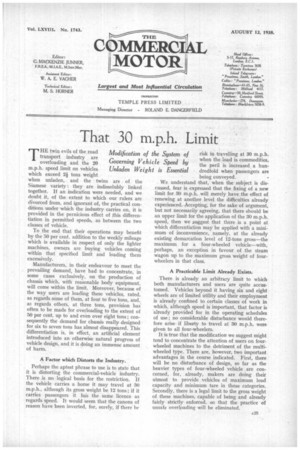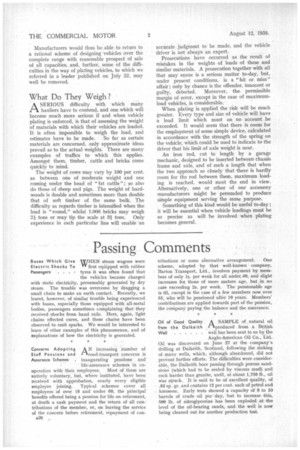That 30 m.p.h.. Limit
Page 27

Page 28

If you've noticed an error in this article please click here to report it so we can fix it.
THE twin evils of the road transport industry are overloading and the 20 m.p.h. speed limit on vehicles which exceed 2i tons weight when unladen, and the twins are of the Siamese variety : they are indissolubly linked together. If an indication were needed, and we doubt it, of the extent to which our rulers are divorced from, and ignorant of, the practical conditions under which the industry carries on, it is provided in the pernicious effect of this differentiation in permitted speeds, as between the two classes of vehicle.
To the end that their operations may benefit by the 50 per cent. addition to the weekly mileage which is available in respect of only the lighter machines, owners are buying vehicles coming within that specified limit and loading them excessively.
Manufacturers, in their endeavour to meet the prevailing demand, have had to concentrate, in some cases exclusively, on the production of• chassis which, with reasonable body equipment, will come within the limit. Moreover, because of the way users are loading these vehicles, rated, as regards some of them, at four to five tons, and, as regards others, at three tons, provision has often to be made for overloading to the extent of 50 per cent, up to and even over eight tons; consequently the demand for chassis really designed for six to seven tons has almost disappenred. This differentiation is, in effect, an artificial element introduced into an otherwise natural progress of vehicle design, and it is doing an immense' amount of harm.
A Factor which Distorts the Industry.
Perhaps the aptest phrase to use is to state that it is distorting the commercial-vehicle industry. There ,is no logical basis for the restriction. If the vehicle carries a horse it may travel at 30 m.p.h., although its gross weight be 12 tons ; if it carries passengers it has the same licence as regards speed. It would seem that the canons of reason have been inverted, for, surely, if there he risk in travelling at 30 m.p.h. when the load is commodities, the peril is increased a hundredfold when passengers are being conveyed.
We understand that, when the subject is discussed, fear is expressed that the fixing of a new limit for 30 m.p.h. will merely have the effect of renewing at another level the difficulties already experienced. Accepting, for the sake of argument, but not necessarily agreeing, that there should be an upper limit for the application of the 30 m.p.h. speed, then we suggest that there is a point at which differentiation may be applied with a minimum of inconvenience, namely, at the already existing demarcation level of 12-tons gross—the maximum for a four-wheeled vehicle—with, perhaps, an exception in favour of the steam wagon up to the maximum gross weight of fourwheelers in that class.
A Practicable Limit Already Exists.
There is already an arbitrary limit to which both manufacturers and users are quite accustomed. Vehicles beyond it having six and eight wheels are of limited utility and their employment is already confined to certain classes of work in which, although speed is important, that factor is already provided for in the operating schedules of use ; no considerable disturbance would therefore arise if liberty to travel at 30 m.p.h. were given to all four-wheelers.
It is true that the modification we suggest might tend to concentrate the attention of users on f ourwheeled machines to the detriment of the multiwheeled type. There are, however, two important advantages in the course indicated. First, there will be no disturbance of design, so far as the heavier types of four-wheeled vehicle are concerned, for, already, makers are doing their utmost to provide vehicles of maximum load capacity and minimum tare in those categories. Secondly, there is a legal limit to the gross weight of these machines, capable of being and already fairly strictly enforced, so that the practice of unsafe overloading will be eliminated. Manufacturers would thus be able to return to a rational scheme of designing vehicles over the complete range with reasonable prospect of sale of all capacities, and, further, some of the difficulties in the way of plating vehicles, to which we referred in a leader published on July 22, may well be removed.
What Do They Weigh ?
ASERIOUS difficulty with which many hauliers have to contend, and one which will become much more serious if and when vehicle plating is enforced, is that of assessing the weight of materials with which their vehicles are loaded.
• It is often impossible to weigh the load, and estimates have to he made. So far as certain materials are concerned, only approximate ideas prevail as to the actual weights. There are many examples of traffics to which this applies. Amongst them, timber, cattle and bricks come quickly to mind.
The weight of cows may vary by 100 per cent. as between one of moderate weight and one coming under the head of "fat cattle"; so also do those of sheep and pigs. The weight of hardwoods is double and sometimes more than double that of soft timber of the same bulk. The difficulty as regards timber is intensified when the load is "round," whilst 1,000 bricks may weigh 21 tons or may tip the scale at 31 tons. Only experience in each particular line will enable an accurate judgment to be made, and the vehicle driver is not always an expert. Prosecutions have occurred as the result of mistakes in the weights of loads of these and similar materials. A prosecution together with all that may ensue is a serious matter to-day, but, under present conditions, is a "hit or miss" affair ; only by chance is the offender, innocent or guilty, detected. Moreover, the. permissible margin of error, except in the case of maximumload vehicles, is considerable.
When plating is applied the risk will be much greater. Every type and size of vehicle will have a load limit which must on no account be exceeded. It would seem that there is room for the employment of some simple device, calculated in accordance with the strength of the spring on the vehicle, which could be used to indicate to the driver that his limit of axle weight is near.
An iron rod, cut to length by a garage mechanic, designed to be inserted between chassis frame and axle, and of such a length that when the two approach so closely that there is hardly room for the rod between them, maximum loading is reached, would meet the end in view. Alternatively, one or other of our accessory manufacturers might be persuaded to produce simple equipment serving the same purpose.
Something of this kind would be useful to-day ; it will be essential when vehicle loadings must be so precise as will be involved when plating becomes general.




















































































